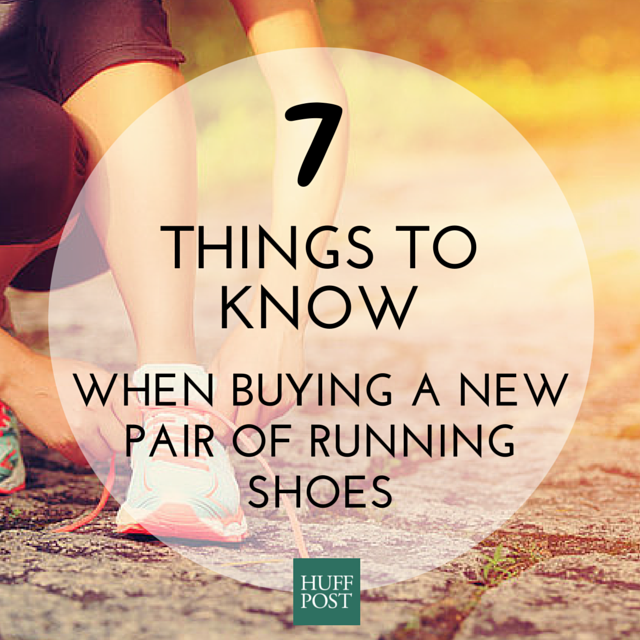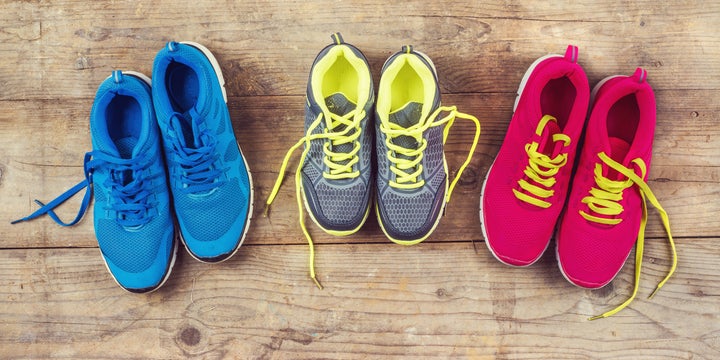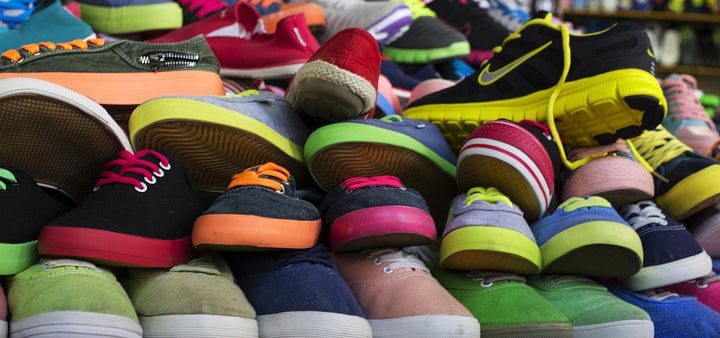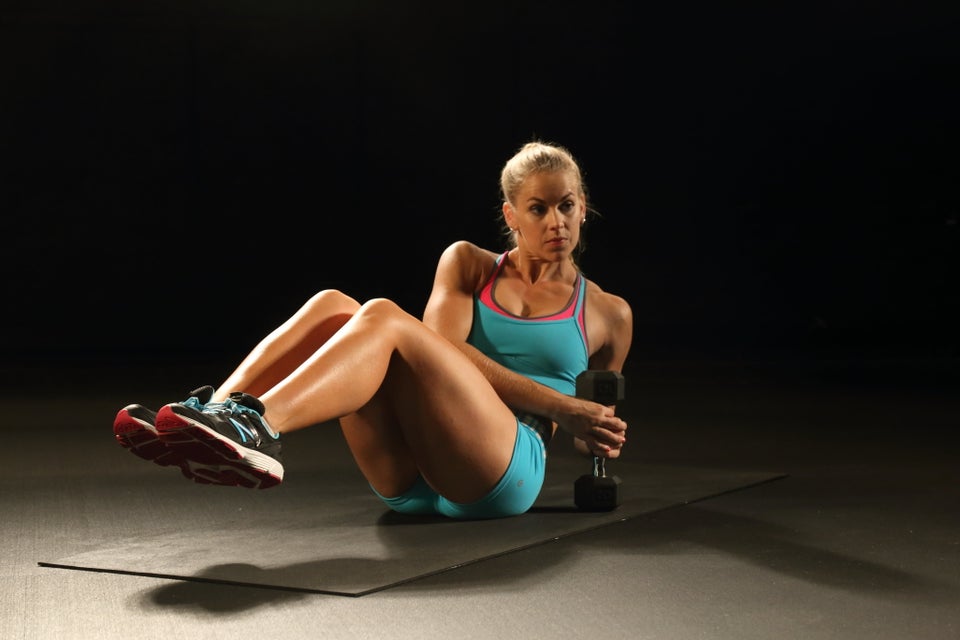When it comes to creating a healthy running routine, sporting the right footwear is as important as actually setting out for those early morning jogs in the first place. But picking the right pair for you? Easier said than done.
At least that's how it feels when you walk into a running shoe store and find yourself staring at an endless wall of styles and (neon) colors. So HuffPost Lifestyle spoke with two running shoe specialists to get the low-down on everything you need to know about finding your best running shoe match before hitting the road.
First things first: You do not have to be a competitive runner to justify getting a shoe custom-fitted for your needs. According to David McQuade of City Sports, being equipped with the proper footwear works wonders for casual walkers and ultra-marathoners alike. In fact, it's critical to your physical health that you wear running shoes that fit and support your feet properly.
"Every time you put your foot down while you're running, imagine that weight times three, because that's the amount of force you're generating when you're running no matter how fast or slow you're going," Mary Arnold of JackRabbit Sports told The Huffington Post. "Without the proper footwear to help absorb some of your repeated exposure to that amount of force, that's going to over time make it more likely that you would have an injury."
With that in mind, here are seven things to think about when buying your next pair of running shoes.

1. Your current fitness level -- and your future aspirations.
The first two questions Arnold asks a customer are: "Are you training for something?" and "What's the distance that you're training for?"
Even if the answer to both of these is "nothing," it's important to understand how you've used your shoes in the past and what you intend to use them for in the future.
"For examaple, with a new runner -- somebody who's just done their first 5K or they're ramping up to do their first half-marathon -- sometimes we want to go with something that's a little more protective just because they're still figuring out their form and we want to minimize the risk of injury there," she said.
People who are running 10 to 20 miles a week are considered low-mileage runners, those in the 20 to 40 miles camp training for half-marathons and the like (which is the bulk of Arnold's clientele) are considered medium-mileage runners, and those who are running more than 40 miles a week are considered high-mileage runners. The amount of cushioning, stability and performance durability they recommend fluctuates depending on the category in which you fall.
2. What injuries you've had and how they affect your current running experience.

Two more important questions: "Are you currently injured?" and "Do you have a history of injuries?"
The type of injury you have may help determine if the running shoes you're currently wearing are related to the issue and how new shoes can fix that. If you're still in recovery, an expert may recommend something more supportive.
"If you have a former injury, you do want to err on the side of caution," said McQuade. "It's always better to go with a shoe that has a bit more structure and a bit more cushion to it, and slowly work your way into lighter, more flexible styles of shoes."
3. Your gait as you run
According to McQuade, understanding your gait and running style is the most important thing that you can do when buying new running shoes.
"Running starts with your feet, so if you're already off alignment in your lower body, each step is another opportunity for you to get injured," said McQuade. "Having the right kind of shoe that's properly aligning your foot really sets you off in the right direction for healthy training."
Some running stores will even do a complimentary gait analysis for you, watching you walk and run while both barefoot and wearing a pair of neutral sneakers to see what your feet and ankles do mid-stance.
Gaits typically fall into three standard types: neutral, overpronated or underpronated. A neutral gait means a person's hips knees and ankles are all in alignment and their arch only flexes a little. An overpronated foot rolls too far inwards and would benefit from a stabilizing shoe. An underpronated foot rolls out and requires more cushioning.
"That third category is very rare -- they're basically unicorns. We we don't see a lot of them," said Arnold.
4. How much space you need

It may seem strange, but you actually want to make sure you have a full thumbnail's worth of empty space in the front of the shoe when you first try it on.
"Almost 90 percent of the people who come in to get fitted for a shoe with me are wearing them too small," said McQuade. "When you run, your feet swell and expand, and you want to be able to accommodate that in a shoe. You never want your toes or foot to be impeded by the shoe."
5. An adjustment gameplan
To avoid unnecessary foot pain, it's important to work your new shoes slowly into your current running routine. Anyone who's ever run a 10K in a brand new pair knows first hand that shocking the feet into a new support system can lead to a whole host of blisters and other complaints.
McQuade recommends keeping your older pair of shoes in rotation, if possible. Start off by wearing your new sneakers for only 20-30 percent of your weekly mileage, and gradually increase that number as you phase out your old pair.
6. What's 'under the hood' of that snazzy design

It may not be the flashiest part, but the most important component of a running shoe is the midsole because it's where the primary form of cushioning and support is located, explained McQuade. A lot of people tend to pay attention to the upper portion of fabric, but that's really just keeping your foot on the shoe. Yes, it's the fun and colorful part, but you really want to focus in on the bottom of the shoe.
Arnold added that the condition of the midsole is often how you can tell if it's time to replace your existing pair of running shoes. If you see any cracking or wrinkling that resembles a smashed packing peanut, it's time to replace those kicks.
7. How your new shoes feel
"The best shoe is the shoe that is specifically tailored to your foot, support- and cushioning-wise," said McQuade. "There's not one shoe that's the best shoe. There's the one shoe that's best for each person."
With that said, if you're someone who benefits from a little more product-focused guidance, the "big four" in specialty running are Brooks, Saucony, Mizuno and Asics, and are often a great place to start if you're new to running and on the hunt for that perfect stride.
"We always ask people about their running feel preference," added Arnold. "Do you like to feel the ground beneath you or do you prefer to float above it?"
More on HuffPost:
